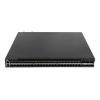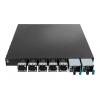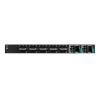-
€



The D-Link DXS-3610 Series Layer 3 Stackable 10G Managed Switches are a set of new, compact, high-performance switches that feature ultra-low latency, suitable for enterprise and campus, as well as service provider’s aggregation network environments. Available in two configurations, 48 x 10G Base-T or 10G SFP+ ports with 6 x 100G QSFP28 that can be used either uplink or stacking5 configurations. The DXS-3610 Series is available with standard as well as enhanced software images. The Standard Image features a wide range of Layer 2, VLAN, multicasting, Quality of Service (QoS), security, data center, and static routing protocols including RIP, VRRP and OSPF. The Enhanced Image features comprehensive IPv4/v6 routing, including BGP and L3 multicasting features such as IGMP, MLD, PIM-DM, SM, SDM, SSM, and DVMRP. The Enhanced Image also supports L2/L3 MPLS VPN, which enables the DXS-3610 Series to be deployed as the core router of an enterprise environment, or as an aggregation switch in an MPLS environment. Furthermore, the Switch Resource Management feature allows the hardware table size to be dynamically adjusted. The DXS-3610 Series also supports essential OpenFlow 1.3 features, enabling the switch to be managed through an OpenFlow controller.
Features
High Performance and Flexibility
- Two hot-swappable power modules for 1+1 power redundancy and load sharing
- Hot-swappable fan trays with front-to-back airflow and N+1 cooling redundancy
- Up to 1200G stacking bandwidth with twelve devices functioning together as a single unit
Data Center Features
- IEEE 802.1Qbb Priority-based Flow Control (PFC) Advanced Features
- MPLS
- ERPS (G.8032 v1/v2)
- MACSec1 (DXS-3610-54T 10G BASE-T port only)
- OpenFlow v1.3
OAM
- IEEE 802.3ah Ethernet link OAM
- IEEE 802.1ag
- ITU-T Y.1731
Specificatons
| DXS-3610-54S/SI | |
| General | |
|---|---|
| Size | 19-inch, 1U rack-mount |
| Interfaces |
48 x 1/10GbE SFP/SFP+ ports |
| Console Port | RJ-45 console port for out-of-band management |
| Management Port | 10/100/1000 BASE-T RJ-45 Ethernet for out-of-band remote management |
| USB Port | 1 x USB 2.0 Type A por |
| Performance | |
| Switching Capacity | 2,16 Tb/s |
| Max. Forwarding Rate | 1607,04 Mp/s |
| Packet Buffer Memory | 32 MB |
| MAC Address Table | Up to 288K |
| IPv4 Routing Table | Up to 32K |
| IPv6 Routing Table | Up to 16K |
| IPv4 Forwarding Table | Up to 144K |
| IPv6 Forwarding Table | Up to 144k |
| Jumbo Frame Size | 9436 bytes |
| Physical | |
| Power Input |
1 + 1 redundant power supply design 100 - 240 V AC, 50/60 Hz |
| Maximum Power Consumption | 320,8 W |
| Standby Power Consumption | 120,6 W |
| Heat Dissipation (Max.) | 1083 BTU/hr |
| Acoustics |
Max: 79.4 dB(A) |
| Fans | 5 x fans |
| Dimensions (W x L x H) | 441.0 x 487.44 x 43.5 mm |
| Weight | 9,80 kg |
| Operating Temperature | 0 to 45 °C |
| Storage Temperature | -40 to 70 °C |
| Operating Humidity | 0% to 95% RH |
|
Storage Humidity |
0% to 95% RH |
| MTBF | 94,262 godzin |
| Certifications | |
| Safety | CB, cUL, LVD |
| EMI/EMC | FCC, CE, C-Tick, IC, VCCI |
| Software features | |
| Stackability |
Virtual Stacking/Clustering of up to 32 units
Physical Stacking
|
| L2 Features | MAC Address Table
Jumbo Frame
Multi-Chassis Link Aggregation Group (MLAG) 802.1AX Link Aggregation
Port Mirroring
Loopback Detection L2 Protocol Tunneling |
| L2 Multicast Features | L2 Multicast Filtering
|
| L3 Features | ARP
IP Interface
IPv6 Neighbor Discovery (ND) IP Helper |
| L3 Routing | Static Routing
Supports hardware routing entries shared by IPv4/IPv6
Policy Based Route Bidirectional Forwarding Detection (BFD)
|
| VLAN | 802.1Q 802.1v Protocol-based VLAN Double VLAN (Q-in-Q)
MAC-based VLAN Subnet-based VLAN Private VLAN VLAN Group
ISM VLAN (Multicast VLAN) Private VLAN Super VLAN VLAN Trunking |
| AAA | 802.1X Authentication
Compound Authentication Microsoft NAP
Authentication Database Failover Trusted Host |
| QoS (Quality of Service) | 802.1p Quality of Service (QoS) 8 queues per port Queue handling
|
| Access Control List (ACL) | ACL based on:
|
| Security | Port Security
D-Link Safeguard Engine DHCP Server Screening IP-MAC-Port Binding (IMPB) Dynamic ARP Inspection IP Source Guard DHCP Snooping IPv6 Snooping DHCPv6 Guard IPv6 Route Advertisement (RA) Guard IPv6 ND Inspection ARP Spoofing Prevention
SSL
DOS Attack Prevention |
| Management | Web-based GUI CLI Telnet Server/Client TFTP Client FTP Client Traffic Monitoring SNMP
System Log DHCP Client DHCP Server DHCP Relay options 12, 60, 61, 82 Multiple Image Multiple Configuration Flash File System Microsoft® Network Load Balancing (NLB) Switch Resource Management (SRM) sFlow DNS Resolver CPU Monitoring MTU Setting Traceroute and Ping LLDP/LLDP-MED DNS Relay SMTP DHCP Auto Configuration SNTP RCP (Remote Copy Protocol) RMONv1 RMONv2 Trusted Host Password encryption Debug command IPv6 Stateless Address Auto-configuration (SLAAC) D-Link Discover Protocol (DDP) D-Link License Management System (DLMS) OpenFlow v1.3 |
| Standards | |
| MIB and RFC Standards | RFC1213 MIB II RFC1907 SNMP v2 MIB RFC5519 IGMP v3 MIB RFC1724 RIP v2 MIB RFC2021 RMONv2 MIB RFC1643, RFC2358, RFC2665 Ether-like MIB RFC4836 802.3 MAU MIB RFC4363 802.1p MIB RFC2618 RADIUS Authentication Client MIB RFC4292 IP Forwarding Table MIB RFC2932 IPv4 Multicast Routing MIB RFC2934 PIM MIB for IPv4 RFC2620 RADIUS Accounting Client MIB RFC2925 Traceroute MIB RFC2925 Ping MIB RFC1850 OSPF MIB Private MIB RFC1112, RFC2236, RFC3376, RFC4541 IGMP Snooping RFC4363 802.1v RFC2338 VRRP RFC1058, RFC1388, RFC1723, RFC2453, RFC2080 RIP RFC1370 Applicability Statement for OSPF RFC1765 OSPF Database Overflow RFC2328 OSPF v2 RFC2740 OSPF for IPv6 RFC3101 OSPF Not-So-Stubby Area (NSSA) option; makes RFC1587 obsolete RFC2328 makes RFC2178 obsolete RFC2178 makes RFC1583 obsolete RFC1771, RFC1997, RFC2439, RFC2796, RFC2842, RFC2918 BGP RFC3973 PIM-DM RFC5059 PIM-SM RFC3569, RFC4601, RFC4608, RFC4607, RFC4604 PIM SSM RFC3376 IGMP RFC2475 Priority Queue Mapping RFC2475, RFC2598 Class of Service (CoS) RFC2597, RFC2598 QoS Flow Actions RFC2697, RFC2698 Three Color Marker, RFC2093, RFC2904, RFC2095, RFC2906 AAA RFC1321, RFC2144, RFC2313, RFC2420, RFC2841, RFC3394 Encryption RFC2289 One-Time RFC3580 802.1X RFC2866 RADIUS Accounting RFC2138, RFC2139, RFC2865, RFC2618 RADIUS Author. for Management Access RFC1492 TACACS+ Auth. for Management Access RFC2068, RFC2616 Web-based GUI RFC854 Telnet Server RFC783, RFC1350 TFTP Client RFC1157, RFC1901, RFC1908, RFC2570, RFC2574, RFC2575, RFC3411-17 SNMP RFC3164 System Log RFC2819 RMON v1 RFC951, RFC1542, RFC2131, RFC3046 BootP/DHCP Client RFC1769 Time Setting RFC2131 DHCP Server RFC1191 MTU Setting RFC1065, RFC1066, RFC1155, RFC1156, RFC2578 MIB Structure RFC1215 MIB Traps Convention RFC4188 Bridge MIB RFC1157, RFC2571-2576, RFC3411-3415, RFC3418 SNMP MIB RFC1901-1908,RFC1442, RFC2578 SNMP v2 MIB RFC2737 Entity MIB RFC768 UDP RFC791 IP RFC792 ICMP RFC793 TCP RFC826 ARP RFC1338, RFC1519 CIDR RFC2716, RFC3748 EAP RFC2571, RFC2572, RFC2573, RFC2574 SNMP |






 Polski
Polski English
English Italiano
Italiano Español
Español Čeština
Čeština Српски
Српски Deutsch
Deutsch Ελληνικά
Ελληνικά Slovenský
Slovenský




